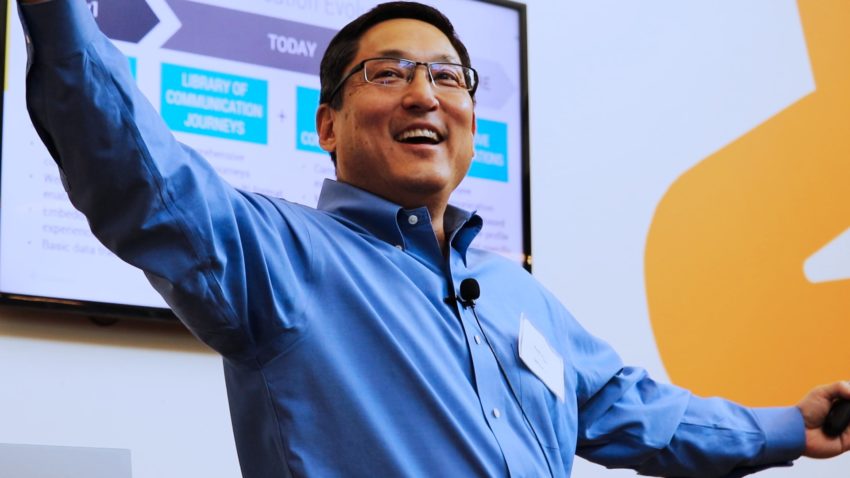“Diversity exists because each of us is an individual – we all have ways to add value, and we all have perspectives,” says Keith Kitani, from GuideSpark.
“Certainly, you can look at it by race, gender, or socioeconomic status. You can group us in different segments but, in the same segment, that doesn’t mean that a millennial is the same as a baby boomer. How they think, act and behave is going to be very different. It’s hard to characterise diversity as a single line.”
Understanding the different perspectives is, he believes, essential for employers to communicate effectively with their employees. Keith is CEO of GuideSpark, which provides technology solutions that help organisations manage, measure and scale their internal communication effectiveness to fully support their business goals.
In a world full of enterprises with diverse populations, together with the range of communication channels and formats, one-size-fits-all no longer works. GuideSpark believes that, with the sheer amount of digital information available, large organisations are struggling to create compelling experiences to suit everyone.
Keith adds: “You have to decide what you can do because it’s impossible to create individual messages. I would love, even in my small company, to send a personalised letter or email to every employee, but it’s just not practical.”
Generational differences
It’s, therefore, essential to understand and concentrate on the areas that will help people. This will vary at different companies and experience levels. While working with HR communications, GuideSpark has learned that there are five generations to consider.
“Not only is it about different learning and information, but it’s about the different context for information,” Keith argues. “The newer generation has always grown up with computers, and so their context around strategies is very different from someone, like me, who started their career without computers.”
He admits that he didn’t set out to make GuideSpark diverse – it happened organically. This was because for, small start-ups, it can be difficult when you “fight for talent to have too many formal programmes”. The culture was more about the people hired and the norms and behaviours.
Some companies have focused heavily on gender diversity and tended to ignore the other protected characteristics. Keith says these “blind spots” are not necessarily on purpose as most people realise that diversity plays a vital role in building a business.
“People have to realise that there are business constraints in all of this,” he explains. “So, no matter what you want to do, it takes time and effort to evolve to the place that you want. Having recognition of the challenges is the best starting point to have. Once somebody has recognised that they have a blind spot, you then look at ways to manage it.”
When speaking with others, Keith often highlights how, as a schoolboy, he and his classmates were racially and socially integrated. They thought diversity was the norm because that’s how they grew up. He suggests that’s why GuideSpark, for a company of its size in Silicon Valley, is fairly diverse. Having a diverse group enables the company to understand the challenges that clients face in communicating with a diverse workforce.
Inclusion by group
Making workplaces inclusive only succeeds when it’s viewed from the employees’ perspective. Says Keith: “Obviously, as I said, it’s hard to tailor messages to every individual because everybody is so different. But you can target groups of employees.
“For example, when it comes to millennials and baby boomers, you can look at what they want in terms of the environment and how whether they feel the company culture makes them feel included. Different generations will feel part of a team differently, based on whether their generational views are recognised.
“It’s about trying to understand those groups and finding ways to personalise that experience for them. If it’s relevant to me, I feel more included.”
Communication is key to how companies connect with employees. The shift to digital and data has created the opportunity to move away from one-size-fits-all to create experiences that make people feel included.
One issue was how to communicate difficult messages. Keith recommends ensuring that such messages align culturally with the organisation. In other words, what’s been the most effective method previously. The next step is to consider how different groups would react.
“The challenge is treating the employee group as a whole because you have conscious and unconscious biases,” Keith argues. “If you just throw it out there, you’re doing everyone a disservice, especially when you have difficult information. The more you can tailor the message from the perspective of the audience, the better.”
A better place
Looking ahead, GuideSpark aims to continue influencing the norms and behaviours that it views as important internally. Externally, the aim is to help organisations, through technology, to measure, target and create more relevant employee experiences.
Asked if there will ever be a time when D&I (diversity and inclusion) will no longer be an issue, Keith thinks not. But, he offers, “we can get it in a better place. We’re going through a good phase where I think people recognise the blind spots that they need to act on to make that better.
“I think there are so many ideas around culture and growing a business that D&I will never be done. You’ve got to continue to work and evolve it.”







